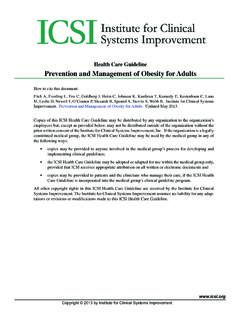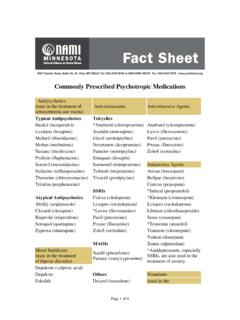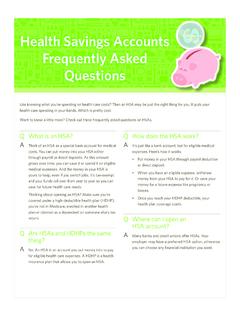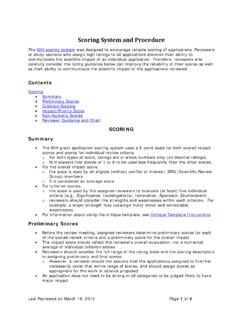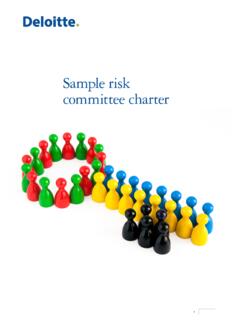Transcription of PHARMACY AND THERAPEUTICS COMMITTEE - HealthPartners
1 August 2021 PHARMACY and THERAPEUTICS COMMITTEE Policies and Procedures I. Charter .. p. 2 II. Formulary Principles .. p. 3 III. Drug Review Process .. p. 4-7 A. When are Medications Reviewed B. How Are Medications Reviewed C. Formulary Listing D. Communication of Changes E. New FDA approvals F. Line Extensions G. Classes of Concern IV. Drug Utilization Management .. p. 8-13 A. Drug Review Process B. Formulary Status C. Specialty Medications D. Generic Substitution Policy E. Biosimilars F. Multi-Source Brand Policy G. OTC Medications H.
2 Herbal Medications I. Compounded Medications V. Prior Authorization Process .. p. 14-15 A. Prior Authorization Request Form B. Hours of Operation C. Appeals Process VI. PHARMACY Programs .. p. 16 A. Transition of Care Policy B. Long Term Care Exception Process C. Therapeutic Interchange D. Member Cost Sharing E. PHARMACY Network VII. Quality Assurance Programs .. p. 17-19 A. Concurrent Drug Utilization Reviews B. Retrospective Drug Utilization Reviews C. Medication Therapy Management (MTM) Programs D. Adherence Programs E. Drug Recalls, Withdrawals, and Safety Advisories F.
3 PHARMACY Fraud, Waste, and Abuse Program G. Sampling Policy VIII. Contact Information .. p. 20 PHARMACY and THERAPEUTICS COMMITTEE , Policies and Procedures, p. 2 of 20 Charter Mission The mission of HealthPartners PHARMACY and THERAPEUTICS (P&T) COMMITTEE is to promote the appropriate use of high quality and cost-effective pharmaceuticals for HealthPartners members. Goals & Objectives Promote the appropriate use of high quality and cost-effective pharmaceuticals for HealthPartners members. Ensure compliance with appropriate standards and state and federal regulations.
4 Functions The PHARMACY and THERAPEUTICS COMMITTEE is responsible for the following major functions: Maintain the Drug Formularies to promote safety, effectiveness, and affordability according to the Formulary Principles. Oversight consists of the Commercial Drug Formularies, the Medicare Formulary, and the State Programs Formulary (Minnesota Health Care Programs). Maintain PHARMACY -related medical policies that promote the safety, effectiveness, and affordability of medications used in clinic settings. Maintain Formulary Principles that guide the management of the Drug Formularies.
5 Review new drugs, drug classes, new clinical indications, therapeutic advantages, new chemical entities, and new safety information. Review the Drug Formularies and therapeutic classes at least annually. Review and update Pharmaceutical Management Policies and Procedures at least annually and as new pharmaceutical information becomes available. Policies are shared regularly with providers in a plan newsletter. Structure & membership The PHARMACY and THERAPEUTICS COMMITTEE reports to the PHARMACY Quality and Utilization COMMITTEE , which reports to the Quality Council.
6 membership consists of broad primary care and specialty representation, a majority of which are practicing physicians and pharmacists from both HealthPartners Medical Group and from Contracted Care providers. membership includes at least one practicing physician and one practicing pharmacist who are experts in the care of the elderly or disabled persons. At least one practicing physician and pharmacist will be free of conflicts of interest from HealthPartners and from pharmaceutical manufacturers. Members and a COMMITTEE Chair are appointed annually by the P&T COMMITTEE chairperson .
7 Members complete a Conflict of Interest disclosure form and a Non-Disclosure Agreement annually. Meetings The PHARMACY and THERAPEUTICS COMMITTEE meets at least quarterly. Minutes reflect the members in attendance, items discussed, and decisions reached. Minutes are forwarded to the PHARMACY Quality and Utilization COMMITTEE and to the Benefits COMMITTEE , and are maintained for at least 10 years in PHARMACY Administration. PHARMACY and THERAPEUTICS COMMITTEE , Policies and Procedures, p. 3 of 20 Formulary Principles The HealthPartners PHARMACY and THERAPEUTICS COMMITTEE develops and maintains its formulary based on these guiding principles.
8 These principles reflect the 6 AIMS (safe, timely, effective, equitable, efficient, and patient centered). These principles are prioritized in descending order ( effectiveness is weighted most heavily, followed by safety issues, and then by cost). Formulary decisions are made following a careful review of these often-competing principles. 1. Proven effectiveness documented in the medical literature. The primary consideration will be the degree to which a medication produces clinically desirable effects. Beneficial effects are assessed on the strength of scientific evidence including peer-reviewed medical literature, pharmacoeconomic studies, and outcomes research, and standards of practice including treatment protocols and evidence-based practice guidelines such as Institute for Clinical Systems Improvement (ICSI).
9 Randomized, controlled trials are weighted most heavily, followed by non-randomized trials, case reports, and medical opinion. 2. Maximizing safety and minimizing the potential for errors. The safety risk / benefit of a product will be compared with other treatments. We will minimize the potential for errors caused by product characteristics such as name, dosage form, and packaging that pose threats to patient safety or increase the potential for errors in the health care system. 3. Optimizing pharmacoeconomics. The overall value of a drug or therapy will be compared with existing treatments to assess PHARMACY costs in relation to medical outcomes.
10 We will consider direct and indirect PHARMACY and medical costs. We will take into consideration and give preference to those agents that optimize the use of financial and service resources over the largest potential population. 4. Emphasis on products essential to health. 5. Significant improvements in patient convenience, adherence, and satisfaction. We will review more favorably products that have significant improvements in patient convenience, adherence, and satisfaction. Examples include variables such as dosing convenience, variety of dosage forms, taste, ability to crush or divide doses, and storage requirements (refrigeration).
